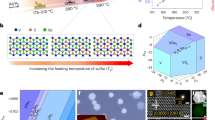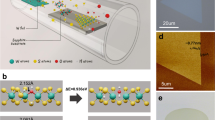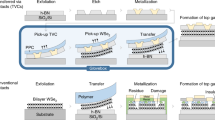Abstract
A key challenge in the development of two-dimensional (2D) devices is the fabrication of metal–semiconductor junctions with minimal contact resistance and depinned energy levels. An ideal solution for practical applications is to make contacts between 2D van der Waals semiconductors and 2D van der Waals metals. Here we report the wafer-scale production of patterned layers of metallic transition metal ditellurides on different substrates. Our tungsten ditelluride and molybdenum ditelluride layers, which are grown using a tellurization process applied to a precursor transition metal layer, have an electronic performance comparable to that of mechanically exfoliated flakes and can be combined with the 2D semiconductor molybdenum disulfide. The resulting metal–semiconductor junctions are free from significant disorder effects and Fermi-level pinning, and are used to create monolayer molybdenum disulfide field-effect transistors. The Schottky barrier heights of the devices also largely follow the trend of the Schottky–Mott limit.
This is a preview of subscription content, access via your institution
Access options
Access Nature and 54 other Nature Portfolio journals
Get Nature+, our best-value online-access subscription
$29.99 / 30 days
cancel any time
Subscribe to this journal
Receive 12 digital issues and online access to articles
$119.00 per year
only $9.92 per issue
Buy this article
- Purchase on Springer Link
- Instant access to full article PDF
Prices may be subject to local taxes which are calculated during checkout




Similar content being viewed by others
Data availability
The data that support the plots within this paper and other findings of this study are available from the corresponding author upon reasonable request.
References
Sze, S. M. & Ng, K. K. Physics of Semiconductor Devices 3rd edn (Wiley-Interscience, 2007).
Liu, W., Sarkar, D., Kang, J. H., Cao, W. & Banerjee, K. Impact of contact on the operation and performance of back-gated monolayer MoS2 field-effect-transistors. ACS Nano 9, 7904–7912 (2015).
Liu, Y. Y., Stradins, P. & Wei, S. H. van der Waals metal-semiconductor junction: weak Fermi level pinning enables effective tuning of Schottky barrier. Sci. Adv. 2, e1600069 (2016).
Schulman, D. S., Arnold, A. J. & Das, S. Contact engineering for 2D materials and devices. Chem. Soc. Rev. 47, 3037–3058 (2018).
Xu, J., Shim, J., Park, J. H. & Lee, S. MXene electrode for the integration of WSe2 and MoS2 field effect transistors. Adv. Funct. Mater. 26, 5328–5334 (2016).
Dimoulas, A., Tsipas, P., Sotiropoulos, A. & Evangelou, E. K. Fermi-level pinning and charge neutrality level in germanium. Appl. Phys. Lett. 89, 252110 (2006).
Allain, A., Kang, J. H., Banerjee, K. & Kis, A. Electrical contacts to two-dimensional semiconductors. Nat. Mater. 14, 1195–1205 (2015).
Liu, Y. et al. Approaching the Schottky–Mott limit in van der Waals metal–semiconductor junctions. Nature 557, 696–700 (2018).
Kim, C. et al. Fermi level pinning at electrical metal contacts of monolayer molybdenum dichalcogenides. ACS Nano 11, 1588–1596 (2017).
Chuang, H. J. et al. Low-resistance 2D/2D ohmic contacts: a universal approach to high-performance WSe2, MoS2, and MoSe2 transistors. Nano Lett. 16, 1896–1902 (2016).
Jeon, J. et al. Epitaxial synthesis of molybdenum carbide and formation of a Mo2C/MoS2 hybrid structure via chemical conversion of molybdenum disulfide. ACS Nano 12, 338–346 (2018).
Chee, S. S. et al. Lowering the Schottky barrier height by graphene/Ag electrodes for high-mobility MoS2 field-effect transistors. Adv. Mater. 31, 1804422 (2019).
Mahajan, M., Murali, K., Kawatra, N. & Majumdar, K. Gate-controlled large resistance switching driven by charge-density wave in 1T-TaS2/2H-MoS2 heterojunctions. Phys. Rev. Appl. 11, 024031 (2019).
Ji, Q. Q. et al. Metallic vanadium disulfide nanosheets as a platform material for multifunctional electrode applications. Nano Lett. 17, 4908–4916 (2017).
Leong, W. S. et al. Synthetic lateral metal–semiconductor heterostructures of transition metal disulfides. J. Am. Chem. Soc. 140, 12354–12358 (2018).
Shin, H. G. et al. Vertical and in-plane current devices using NbS2/n-MoS2 van der Waals Schottky junction and graphene contact. Nano Lett. 18, 1937–1945 (2018).
Dawson, W. G. & Bullett, D. W. Electronic-structure and crystallography of MoTe2 and WTe2. J. Phys. C 20, 6159–6174 (1987).
Song, S. et al. Electrically robust single-crystalline WTe2 nanobelts for nanoscale electrical interconnects. Adv. Sci. 6, 1801370 (2019).
Komsa, H. P. et al. Two-dimensional transition metal dichalcogenides under electron irradiation: defect production and doping. Phys. Rev. Lett. 109, 035503 (2012).
Mleczko, M. J. et al. Contact engineering high-performance n-type MoTe2 transistors. Nano Lett. 19, 6352–6362 (2019).
Yun, S. J. et al. Telluriding monolayer MoS2 and WS2 via alkali metal scooter. Nat. Commun. 8, 2163 (2017).
Zhou, J. D. et al. Large-area and high-quality 2D transition metal telluride. Adv. Mater. 29, 1603471 (2017).
Kim, T. et al. Wafer-scale epitaxial 1T′, 1T′–2H mixed, and 2H phases MoTe2 thin films grown by metal–organic chemical vapor deposition. Adv. Mater. Interfaces 5, 1800439 (2018).
de Melo, O. et al. WTe2 Synthesis by tellurization of W precursors using isothermal close space vapor transport annealing. Phys. Status Solidi A 215, 1800425 (2018).
Huang, J. H. et al. Large-area 2D layered MoTe2 by physical vapor deposition and solid-phase crystallization in a tellurium-free atmosphere. Adv. Mater. Interfaces 4, 1700157 (2017).
Kwak, J. et al. Single-crystalline nanobelts composed of transition metal ditellurides. Adv. Mater. 30, 1707260 (2018).
Kim, S. Y., Kwak, J., Ciobanu, C. V. & Kwon, S.-Y. Recent developments in controlled vapor-phase growth of 2D Group 6 transition metal dichalcogenides. Adv. Mater. 31, 1804939 (2019).
Lee, C. H. et al. Tungsten ditelluride: a layered semimetal. Sci. Rep. 5, 10013 (2015).
Li, J., Cheng, S., Liu, Z. X., Zhang, W. F. & Chang, H. X. Centimeter-scale, large-area, few-layer 1T′-WTe2 films by chemical vapor deposition and its long-term stability in ambient condition. J. Phys. Chem. C 122, 7005–7012 (2018).
Zhou, Y. et al. Direct synthesis of large-scale WTe2 thin films with low thermal conductivity. Adv. Funct. Mater. 27, 1605928 (2017).
Fei, Z. Y. et al. Edge conduction in monolayer WTe2. Nat. Phys. 13, 677–682 (2017).
Asaba, T. et al. Magnetic field enhanced superconductivity in epitaxial thin film WTe2. Sci. Rep. 8, 6520 (2018).
Woods, J. M. et al. Suppression of magnetoresistance in thin WTe2 flakes by surface oxidation. ACS Appl. Mater. Interfaces 9, 23175–23180 (2017).
Mleczko, M. J. et al. High current density and low thermal conductivity of atomically thin semimetallic WTe2. ACS Nano 10, 7507–7514 (2016).
Liu, X. et al. Gate tunable magneto-resistance of ultra-thin WTe2 devices. 2D Mater. 4, 021018 (2017).
Song, S. M., Park, J. K., Sul, O. J. & Cho, B. J. Determination of work function of graphene under a metal electrode and its role in contact resistance. Nano Lett. 12, 3887–3892 (2012).
Park, H. Y. et al. Extremely low contact resistance on graphene through n-type doping and edge contact design. Adv. Mater. 28, 864–870 (2016).
Russo, S., Craciun, M. F., Yamamoto, M., Morpurgo, A. F. & Tarucha, S. Contact resistance in graphene-based devices. Physica E 42, 677–679 (2010).
Nagashio, K., Nishimura, T., Kita, K. & Toriumi, A. Contact resistivity and current flow path at metal/graphene contact. Appl. Phys. Lett. 97, 143514 (2010).
Gao, M. et al. Tuning the transport behavior of centimeter-scale WTe2 ultrathin films fabricated by pulsed laser deposition. Appl. Phys. Lett. 111, 031906 (2017).
Liu, W. L. et al. Effect of aging-induced disorder on the quantum transport properties of few-layer WTe2. 2D Mater. 4, 011011 (2017).
Wang, L. et al. Tuning magnetotransport in a compensated semimetal at the atomic scale. Nat. Commun. 6, 8892 (2015).
Ye, F. et al. Environmental instability and degradation of single- and few-layer WTe2 nanosheets in ambient conditions. Small 12, 5802–5808 (2016).
Yu, L. L. et al. Graphene/MoS2 hybrid technology for large-scale two-dimensional electronics. Nano Lett. 14, 3055–3063 (2014).
Bark, H. et al. Large-area niobium disulfide thin films as transparent electrodes for devices based on two-dimensional materials. Nanoscale 10, 1056–1062 (2018).
Lu, Q. et al. Experimental investigation of the contact resistance of graphene/MoS2 interface treated with O2 plasma. Superlattice Microstruct. 114, 421–427 (2018).
Du, Y. C. et al. MoS2 field-effect transistors with graphene/metal heterocontacts. IEEE Elect. Dev. Lett. 35, 599–601 (2014).
Liu, Y. et al. Toward barrier free contact to molybdenum disulfide using graphene electrodes. Nano Lett. 15, 3030–3034 (2015).
Leong, W. S. et al. Low resistance metal contacts to MoS2 devices with nickel-etched-graphene electrodes. ACS Nano 9, 869–877 (2015).
Kwon, J. et al. Thickness-dependent Schottky barrier height of MoS2 field-effect transistors. Nanoscale 9, 6151–6157 (2017).
Dathbun, A. et al. Selectively metallized 2D materials for simple logic devices. ACS Appl. Mater. Interfaces 11, 18571–18579 (2019).
Guimaraes, M. H. D. et al. Atomically thin ohmic edge contacts between two-dimensional materials. ACS Nano 10, 6392–6399 (2016).
Wang, Y. et al. van der Waals contacts between three-dimensional metals and two-dimensional semiconductors. Nature 568, 70–74 (2019).
Kaasbjerg, K., Thygesen, K. S. & Jacobsen, K. W. Phonon-limited mobility in n-type single-layer MoS2 from first principles. Phys. Rev. B 85, 115317 (2012).
Das, S., Chen, H. Y., Penumatcha, A. V. & Appenzeller, J. High performance multilayer MoS2 transistors with scandium contacts. Nano Lett. 13, 100–105 (2013).
English, C. D., Shine, G., Dorgan, V. E., Saraswat, K. C. & Pop, E. Improved contacts to MoS2 transistors by ultra-high vacuum metal deposition. Nano Lett. 16, 3824–3830 (2016).
Shen, T., Ren, J. C., Liu, X. Y., Li, S. & Liu, W. van der Waals stacking induced transition from Schottky to ohmic contacts: 2D metals on multilayer InSe. J. Am. Chem. Soc. 141, 3110–3115 (2019).
Lee, D. H. et al. Ultrathin graphene intercalation in PEDOT:PSS/colorless polyimide-based transparent electrodes for enhancement of optoelectronic performance and operational stability of organic devices. ACS Appl. Mater. Interfaces 11, 21069–21077 (2019).
Wang, Q. S. et al. Room-temperature nanoseconds spin relaxation in WTe2 and MoTe2 thin films. Adv. Sci. 5, 1700912 (2018).
Acknowledgements
This work was supported by the Nano-Material Technology Development Program (Grant no. 2017M3A7B8065377) through the National Research Foundation (NRF) of Korea funded by the Ministry of Science, ICT and Future Planning. This work has benefited from the use of the facilities at UNIST Central Research Facilities.
Author information
Authors and Affiliations
Contributions
S.S. performed most of the experiments with assistance from Y.S., S.-Y. Kim, D.H.L., J.W., S.Y., Y.L., J.K., J.-H.C.; J.H.K. and Z.L. performed the high-resolution TEM imaging of the samples; I.O. and J.-W.Y. performed the low-temperature magnetoresistance measurements; W.N. and H.C. performed the Raman measurements; S.S. and S.-Y. Kwon wrote the manuscript; all the authors revised and commented on the manuscript; S.-Y. Kwon planned and supervised the project.
Corresponding author
Ethics declarations
Competing interests
The authors declare no competing interests.
Additional information
Publisher’s note Springer Nature remains neutral with regard to jurisdictional claims in published maps and institutional affiliations.
Supplementary information
Supplementary Information
Supplementary Notes 1 and 2, Figs. 1–24 and Tables 1–3.
Rights and permissions
About this article
Cite this article
Song, S., Sim, Y., Kim, SY. et al. Wafer-scale production of patterned transition metal ditelluride layers for two-dimensional metal–semiconductor contacts at the Schottky–Mott limit. Nat Electron 3, 207–215 (2020). https://doi.org/10.1038/s41928-020-0396-x
Received:
Accepted:
Published:
Issue Date:
DOI: https://doi.org/10.1038/s41928-020-0396-x
This article is cited by
-
High spin current density in gate-tunable spin-valves based on graphene nanoribbons
Scientific Reports (2023)
-
Vapour-phase deposition of two-dimensional layered chalcogenides
Nature Reviews Materials (2023)
-
Two-dimensional metallic alloy contacts with composition-tunable work functions
Nature Electronics (2023)
-
Contact-engineered reconfigurable two-dimensional Schottky junction field-effect transistor with low leakage currents
Nature Communications (2023)
-
Fabrication of p-type 2D single-crystalline transistor arrays with Fermi-level-tuned van der Waals semimetal electrodes
Nature Communications (2023)



